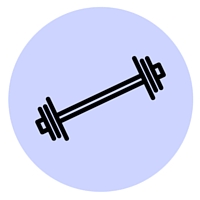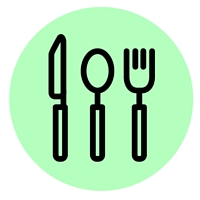Supermarket Savvy: 9 Grocery Shopping and Food Storage Tips for Healthier Meals
/The grocery store can make or break your healthy lifestyle habits. And with the hard work you've put into your fitness regimen, you don't want to destroy all the gains you've been making with unhealthy, nutrient-poor foods! Here are some of my general tips for navigating the grocery store healthfully, and ways to not break the bank while doing so.
1 | Don't go shopping hungry.
This might be an obvious tip, but going grocery shopping hungry inevitably leads to impulse buying. And more often than not, those impulse food purchases come in the form of nutrient-poor, high-calorie snack foods (unless you have the strongest willpower known to man!). You know, the cookies that look so good on the package, those chips that you can't live without, and oh, the chocolate cake or candy bars right at eye level. To avoid filling your cart with unnecessary goodies, chow down before you go. Go shopping after breakfast or after dinner. If you're planning on stopping by the store on the way home, make sure to plan ahead and pack yourself a quick snack (protein bar, an apple, a banana, a yogurt, etc.) and have it right before you leave.
2 | Plan your meals.
Obviously you need some type of plan before you go grocery shopping. But the type of planning I'm talking about is really sitting down and planning out your meals for the week. Yes, the week. A lot of you probably already do this, but I find it really helpful to take a weekend day (say, Sunday) and write out what meals you will have for the week ahead. That includes breakfast, lunch, dinner, and your snacks. That way you will know ahead of time what you are going to need to buy at the store and won't be left wondering what's for dinner mid-week.
3 | Make a list and stick to it.
Making a list is important not only so you don't forget those key items, but also so you don't willy-nilly grab things that you don't need. Buy only the ingredients that you NEED for your meals and snacks for the coming days or week. This will help avoid the junk food stockpile and also keep the grocery bill down.
4 | Check the weekly circulars and clip coupons.
I used to not be a big coupon person. I never bothered to check those mailer inserts for bargains. I just went to get what I needed and that was that. Within the past few years though, I've started taking the time to actually look through the weekly circulars from local grocery stores to see where I could get the best deals. Sometimes this means going to multiple stores to save a little bit of money, but more often than not I will go to the store that has the most items I need on sale. I'll also cut coupons for the items I know I will need. A few cents saved here and there can really add up - especially if your store doubles coupons! For a quick guide on coupon doubling, click here.
5 | Buy items on sale (and stock up).
After you've done your research in the weekly circulars, buy the items that are on sale. Even if you aren't going to use them in that week's meal plan, there's no harm in buying things that you will use eventually. Canned goods on sale this week? Great! Stock up! Chicken breast is buy one get one free? Awesome, grab a few! You can always freeze what you won't be using immediately, or if it's safe to store at room temperature, store it on the shelf.
6 | Buy in season.
In-season fresh veggies and fruits are way more flavorful than those bought out of season. Not to mention, in-season produce is often cheaper. Try to make recipes and meals using what fruits and veggies are in their prime at the time and you'll save money in your wallet and add flavor to your plate. It's Fall right now, so all the squashes, apples, pomegranates, kale, etc. are ripe for the picking. Scroll to the bottom of the post to see a handy chart for what's in season at what time. You can also click here for a handy interactive map of peak-season produce by month.
7 | Check the label.
It might add a few minutes to your grocery shopping trip, but taking the time to actually turn the package over to read the ingredient list and nutritional information can make a world of difference. Opt for low(er)-sodium or no-salt added items, especially if they are canned or jarred, premade spice mixes, or premade soups. Also choose items with no sugar added. (Examples: canned/packaged fruit, salad dressing, etc.) Check the actual list of ingredients below the label, too. Click here for the FDA's quick reference guide to food labels and nutritional information (very helpful!).
8 | Keep items in sight.
A lot of money is wasted on produce that just sits in the fridge, out of sight and unused. I'm completely guilty of this. This past week I was fully intending on cooking 2 packages of butternut squash, but when I opened the drawer to get them out, they were moldy and unusable. Bummer! I find it's most helpful to put the items that spoil easily within eyesight or at eye level in your fridge, or on the shelf. That way you'll be reminded that you have it, and will be more likely to use it or eat it before it goes bad.
9 | Freezers are your best friend.
So chicken breast was on sale this week and you stocked up? You bought a huge supply of veggies that you can't possibly use up all at once? Or you made a crockpot full of soup that definitely won't be eaten by Friday? Freeze it! Store extra food or leftovers in the freezer if you aren't going to be using them immediately, and thaw when you need them. (A somewhat obvious pointer on freezing large quantities of soup/stew: freeze in multiple containers holding a few servings each. That way you don't have to thaw another huge quantity that you won't be able to eat before it goes bad.)
Found at: www.epicurious.com
Keep these things in mind the next time you're heading out to the grocery store. Until next time, here's to a week of healthy and happy shopping, meal planning, and eating! Have a great week everyone!
Readers: chat with me! What tips do you have for planning ahead and making the most out of your grocery shopping? What do you usually shop for? Favorite stores?





![Strawberry Basil Smoothie + Green Blender Review [Part 1]](https://images.squarespace-cdn.com/content/v1/53b084b0e4b01260143c2d2a/1462322275731-410EB5YH74NYJ4LVA9DC/2016-05-02+17.19.00-2.jpg)



































